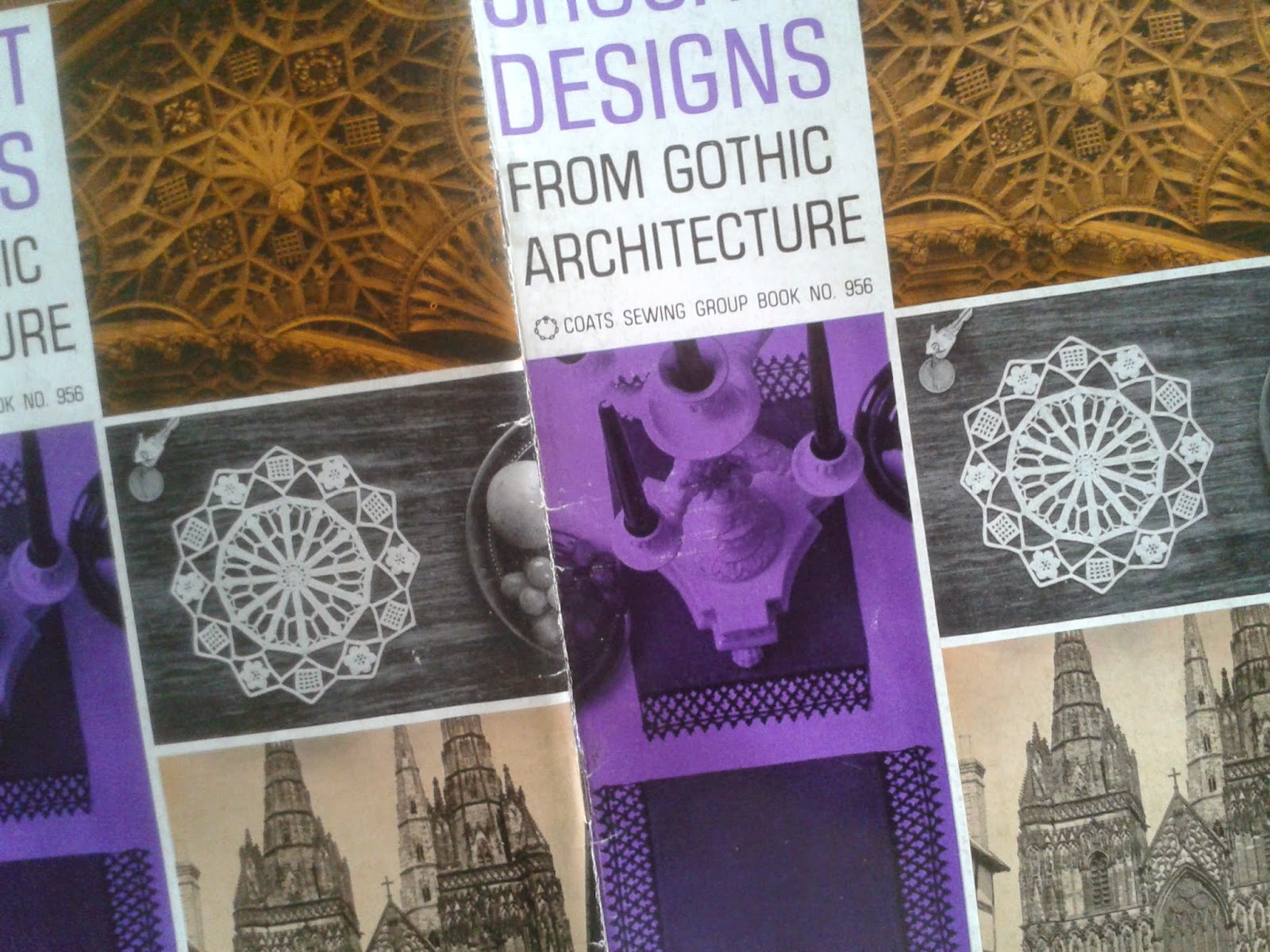I was
delighted to come across this book of gothic crochet designs from 1964.
Unfortunately they are based on gothic architecture rather than the spooky kind
of gothic, which would have been really exciting, but they are interesting none
the less. They are all in the same style and seem to have been designed by the
same person but sadly his or her name is not given. They are all worked in
Coats Mercer-Crochet no 20 using a no 3 crochet hook. Most of the designs are
for round mats based on such exalted sites as the Rose window of Chartres
Cathedral and the fan vaulting of King’s College Chapel Cambridge. However
there are also some edgings based on the West Front of Lichfield Cathedral and
tracery at St Lorenz, Nuremburg. What impresses me is that the Coats Sewing
Group had the commitment to design, in the early 60s, to commission crochet
mats based on a theme like this.
Wednesday 26 November 2014
Wednesday 19 November 2014
Lace doilies
I’ve been doing some research into
lace doilies and was delighted to find these at the Lace Guild. They cover a
variety of techniques including Bedfordshire bobbin lace, crochet, tatting, and
netting. It seems that doilies were
named after a draper with a shop in the Strand in London, in the early
nineteenth century. However, I’ve also discovered that it is quite difficult to
define a doily as there are many types of lace mat and combinations of lace
mats including luncheon sets, cheval sets, coasters and tray cloths. It’s a
case of ‘you know one when you see one’, but defining it is not so easy!
Monday 10 November 2014
Tuberculosis lace design
I’m designing
some lace as part of my research into domestic conditions in the nineteenth
century. It will be embedded in silk paper to represent the idea of the
curtains of the home and the lungs of the body being clogged up with germs and particles
from the air. I’ve decided to base it on the tuberculosis bacterium as TB is a
disease of overcrowded living conditions, which we associate with that period of
history. I’ve found some images of the bacteria and they seem to be long
lozenge shapes, so I’m using them as the central motif of the lace, embedded in
a fairly open half-stitch background. I also want to add some trapped particles
so I will intersperse the ground with cocoon-like shapes, probably in thicker
threads. Most of the lace will be covered in silk paper or have silk paper
overlaying it so making the lace too fine would be a waste of effort. I’m not
sure how to design the edges yet but will probably opt for some sort of
scalloped shape to make it easier to attach the silk paper when I come to make
that. I’ll keep you posted!
Wednesday 5 November 2014
Releve, pirouette, What now?
This is the title of an intriguing exhibition of work by Chien-Wei Chang at the Crafts Study Centre
at Farnham. He is a metalworker and often combines silver with found natural
materials. As a Taiwanese artist living in the UK he brings two different
aesthetics together in his work and much of it is physically composed of two
artefacts split and rejoined. I was very taken with his pieces made from small
containers and spoons (the works are not titled) – they appeared to me like
tiny reliquaries, just the right size to hold in the palm of the hand, and held
the promise of hidden meanings. Splitting of objects pervaded the entire
exhibition, with vessels and furniture cut and displayed in two parts, alluding
to the two aspects of Chang’s life coming together to produce this fascinating
work.
Saturday 1 November 2014
Lacemakers exhibition at Orleans House Gallery
This is a
mixed exhibition of lace and work inspired by lace, at the Stables gallery at
Orleans House, Twickenham. Although it includes a complete mixture of textiles,
drawings, prints, ceramics, and jewellery, they are all linked by the thread of
lace and come together to form a pleasing exhibition. I liked some of the
contrasts created, such as the texture of Gail Baxter’s felt and bobbin lace
‘Cover cloth’ compared with the pristine lines of Teresa Whitfield’s ‘Charlotte
Bronte’s shawl’ (both shown in the image above). It was interesting to see
Hannah White’s light reflective collar ‘Lace tracks’ and Gill Bird’s ‘Raised
and rolled’ black and white wired piece. Gill Smith’s cut paper giving the
illusion of an open door and its shadow was both beautiful and clever, as was
Dawn Cole’s printed collar incorporating text entitled ‘Men had eyes removed’.
Janice Webb’s
collaged pieces also contrasted with Lizzie Lee’s conical lampshades made of
recycled lace (pictured). I also liked Beth Walsh’s use of bobbin and needle
lace in her hanging ‘Porta della carta’ and the more formal lines of Clare
Sams’ filet lace ‘I loved you’ antimacassar. It was nice to see Tamara
Goulding’s three dimensional needlelace ‘Floating’ and contrast it with Maggie
Bonsey’s delicate, black, three dimensional geometric forms.
I thought Gil
Dye’s tiny lace collars and Dorie Millerson’s small needle lace vehicles could
have been displayed to greater effect. Gil’s work would have benefited from
being seen from above and Dorie’s from better lighting and shadows. In
contrast, Emma Tann’s black crochet and embroidery installation was beautifully
and painstakingly displayed at one end of the gallery (image above). It is
always difficult to hang a mixed exhibition and, on the whole, I thought the curators
had done a great job and produced an interesting exhibition, expanding the
theme of lace beyond the textile.
Subscribe to:
Posts (Atom)







